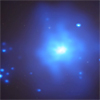CXC Home | Search | Help | Image Use Policy | Latest Images | Privacy | Accessibility | Glossary | Q&A
Tour of NGC 1399
Quicktime MPEG
Evidence from NASA's Chandra X-ray Observatory and the Magellan telescopes in Chile suggest that a star has been torn apart by an intermediate-mass black hole. In this image, x-rays from Chandra are shown in blue and are overlaid on an optical image from the Hubble Space Telescope in the galaxy known as NGC 1399. The Chandra observations show that one of these objects is a so-called ultraluminous x-ray source, or ULX. ULXs are an unusual class of objects. They emit more x-rays than any known star, but less than the bright x-ray sources associated with supermassive black holes. They may actually be an elusive middle-sized black hole that astronomers have been looking for. If confirmed, this latest discovery from Chandra would be a cosmic double-play. It would be strong evidence for this intermediate-mass black hole, and it would mark the first time such a black hole has been caught tearing apart an entire star.
[Runtime: 01:02]
Quicktime MPEG
Evidence from NASA's Chandra X-ray Observatory and the Magellan telescopes in Chile suggest that a star has been torn apart by an intermediate-mass black hole. In this image, x-rays from Chandra are shown in blue and are overlaid on an optical image from the Hubble Space Telescope in the galaxy known as NGC 1399. The Chandra observations show that one of these objects is a so-called ultraluminous x-ray source, or ULX. ULXs are an unusual class of objects. They emit more x-rays than any known star, but less than the bright x-ray sources associated with supermassive black holes. They may actually be an elusive middle-sized black hole that astronomers have been looking for. If confirmed, this latest discovery from Chandra would be a cosmic double-play. It would be strong evidence for this intermediate-mass black hole, and it would mark the first time such a black hole has been caught tearing apart an entire star.
[Runtime: 01:02]
(Credit: X-ray: NASA/CXC/UA/J. Irwin et al; Optical: NASA/STScI)
Return to NGC 1399 (January 4, 2010)



